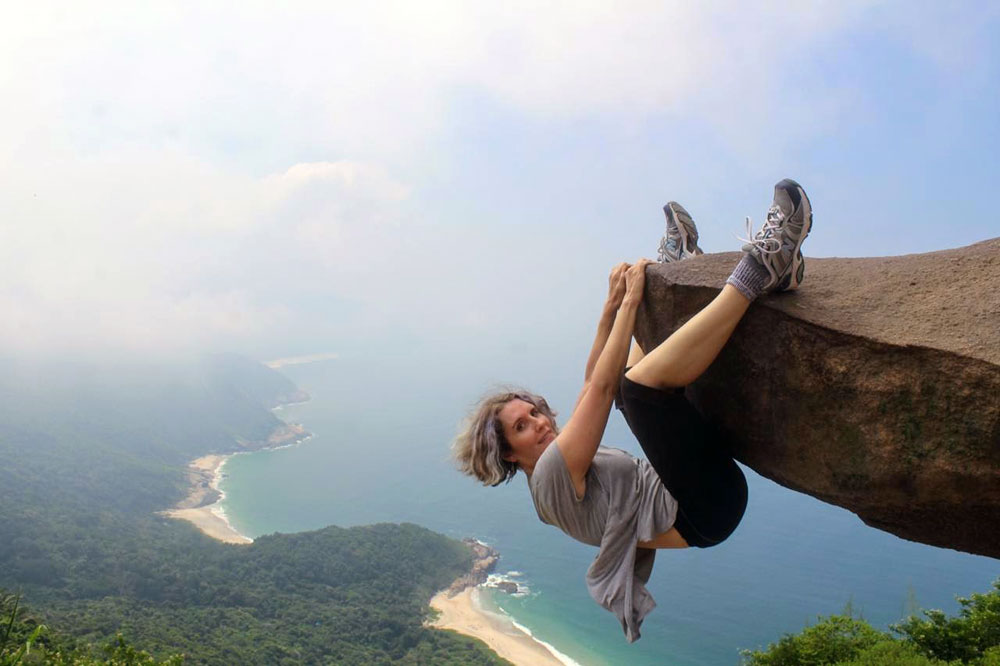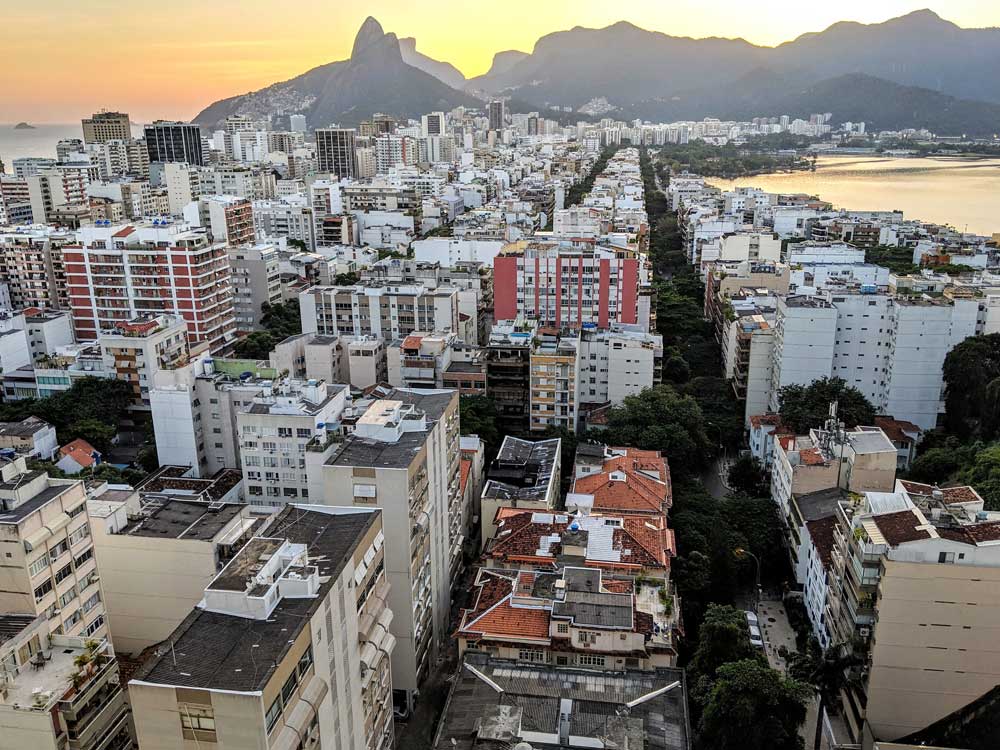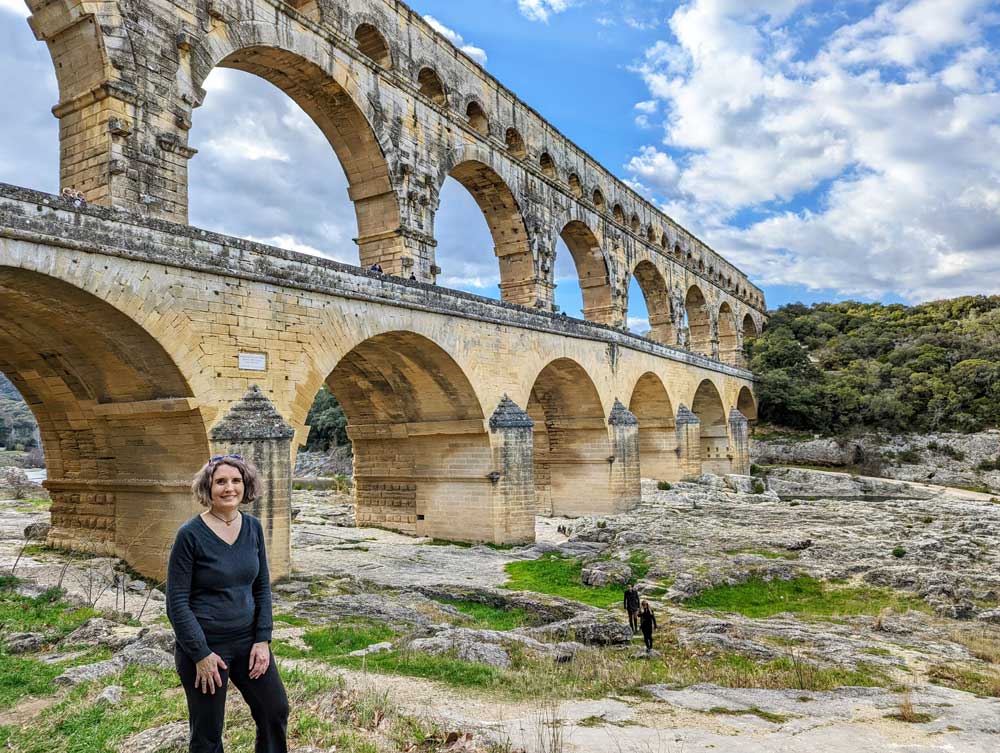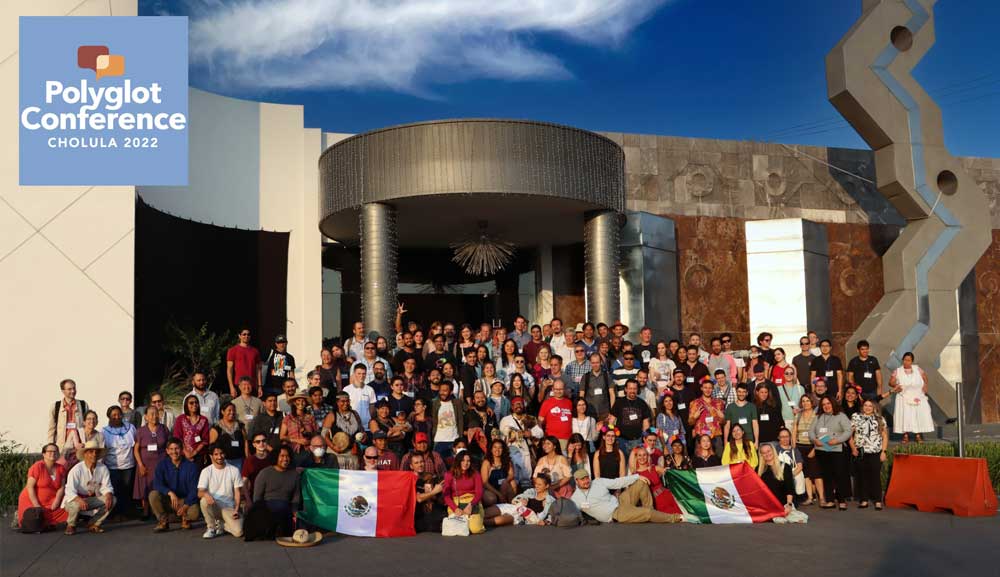

I met Ingrid this spring when we were traveling through Albuquerque, New Mexico in our campervan. We met up for a fun evening with the Choose FI ABQ Crew.
Ingrid retired early about eight years ago. As we got chatting, she said, “I wish there had been more info about Slow FI when I was coming up.”
Of course, I wanted to learn more, and that conversation turned into this interview.
Periodically, I feature people in the Slow FI interview series who have retired early. I love hearing their learnings and sharing their wisdom about what they’d do differently.
Let’s jump into the interview!
1. Tell me about you.
I’m a 51-year-old FIREd human. I quit software engineering at 43 to devote myself to language learning, travel, writing, and photography.
I love to combine language study with travel. My FIRE goal has been to learn a new language and get to at least a conversational level every two years.
My first project was getting my rusty Spanish to fluency. Next were Portuguese and French. My current project is Italian.
In non-pandemic times, I travel about four months a year, usually on language-study-related trips. I also blog about languages and travel.
When not on the road, I live in the American Southwest. I love the relaxed pace, Hispanic influence, and low cost of living.
2. Why did you decide to pursue financial independence in the first place?
Growing up, I was fascinated by language learning, travel, and writing. As a teen, I went to Mexico and Switzerland on language exchanges. After college, I spent three years working in London, using my earnings to backpack through Asia and the Middle East.


After returning to the US at 25, I settled into a professional job and adult life. But, full-time work in a cubicle felt stifling. I was always researching alternatives. I considered teaching English overseas and massage therapy.
At 27, I started a master’s in computer science for more earning power and job flexibility. I attended a bridge program for people without a computer science undergraduate degree at a University of Texas campus. Back then (around the year 2000), UT graduate tuition was only a few hundred dollars a semester.
Around the same time, I discovered the FIRE movement with online forums and books like Your Money Or Your Life. I began saving towards FIRE in 2003 after starting work as a software engineer.
My last job was with a large tech firm that was supportive of women and generous with its employees. But I hated the stress and Dilbert-like absurdity of many of my projects.
I always maxed out vacation days and took unpaid time off when possible to travel and learn languages. But it never felt like enough. This is what motivated me most to pursue FIRE.
Furthermore, pursuing this lifestyle did not feel completely countercultural in my family. My parents are German immigrants to the US, and they taught me the value of saving and investing early on.
I grew up in a Texas upper-middle-class neighborhood where it was the norm to live way beyond your means. My parents didn’t. It wasn’t always easy being the only kid on the block with a patched-up clunker as the family car! Now, I admire my parents’ frugality.
My parents also passed on to me a respect for work-life balance. Germans have a strong work ethic, but they also take time off very seriously. Because of that, it seems like Germany enjoys a better quality of life than the US, despite higher taxes and lower salaries for skilled jobs.
My parents thought American corporate culture was crazy. So, they chose jobs like a university professor and a part-time programmer, that allowed for big chunks of time off. During my childhood, we spent summers with family in Europe or tent camping in the US and Canada.
My parents prioritized frugal experiences over material possessions. They were always generous, though, with charitable giving, tips, and helping family members in need.
Because of my minimalist upbringing, saving for FIRE never felt like a sacrifice. Several family members are also Vanguard diehards, and we often geek out talking about financial topics. I feel lucky to have so much support and understanding from my family.
Lastly, I also believe that my personality played a role in motivating me to pursue FIRE. As a Myers-Briggs INTJ, I dislike rules and artificial limitations. Being introverted also means I thrive alone away from the social environment of an office.
I need a lot of space and autonomy. INTJs resent having their time and effort controlled by others. I’m so much happier working on self-directed projects like language learning and blogging!
3. How did you approach your FI journey?
I had always been an aggressive saver. Once I started my software engineering career, my earnings grew quickly. At its peak, I was saving 50% of my gross income. Reaching FIRE took 13 years.
My investment strategy was nothing groundbreaking. I had low-cost index funds with Vanguard and Fidelity. Since women in my family often live into their 90s, I was looking at a potential 50-60-year retirement. A 4% withdrawal rate felt too aggressive to me for that duration, so I targeted a net worth that supported a 2-3% withdrawal rate. I’ve stuck to that.
Now, my finances are on autopilot. Before FIRE, I checked my net worth obsessively. These days, I just log on once a quarter to record dividend distributions. I also rebalance annually if needed during my Roth conversions around January 1st.
4. When did you reach FI? Tell us more about your transition to your full FIRE lifestyle.
My goal was to retire at 45, but due to strong stock market returns I was able to quit at 43, two years ahead of schedule. I left my job at the end of January 2016. Since company bonuses were paid out in January, I could still max out my 401(k) and IRA contributions for the year.
To prepare for FIRE, I tracked expenses for eight years. I paid off my house. Even though I had a low-interest mortgage, it felt important for me to be debt-free when I left work. I also wanted to minimize annual expenses.
I had a unique opportunity to test-drive early retirement before quitting. In my last year of work, I joined an experimental group at my tech company that allowed salaried employees to work as freelancers.
I worked half-time on a three-month-on, three-month-off schedule. I escaped the dysfunctional projects I was on previously and pursued open-source web development, something that had always intrigued me but I had never had the chance to pursue at work.
I used the three-month stints off to travel to Europe and Asia. The time off was blissful. My half-time position was better than any job I had ever had.
But, I soon discovered my new projects had their fair share of dysfunction as well. Because I was already FI (and knew I didn’t have to be there), I found it increasingly difficult to return to work after each three-month stretch of freedom.


During my last three-month-off stint, I started my travel blog, resurrected my rusty Spanish, and planned a study trip to Mexico. The transition was fairly seamless.
I’m happiest when busy and productive, and blogging and language learning provided an instant routine to step into. Soon after my last work day, I departed for seven weeks of Spanish study in Mexico and never looked back.
I also tried to change things gradually after reaching FIRE. I’m grateful I was able to do it that way as it greatly decreased stress levels. I changed as few other variables as possible. For example, I stayed in my current house and got COBRA so my health plan didn’t change.
I also want to acknowledge the role privilege and luck played in reaching FI. If my German parents had not emigrated to the US, I doubt FIRE would even have been on my radar.
If I hadn’t grown up in such a frugal household, and if my family hadn’t encouraged me to pursue a lucrative but stereotypically male profession, achieving FIRE would have been much harder. And I was fortunate that my parents paid for my undergraduate degree, allowing me to start adult life without debt.
5. What does your FI lifestyle look like? Were there things you didn’t expect?
Now that pandemic travel restrictions are over, I’m traveling about a third of the time again. I take about three international and three domestic trips a year.
At home, I do two to eight hours a day of language learning. Much of that though is passive consumption: YouTube, podcasts, or books in the target language. Trip planning also consumes many hours. I exercise at least an hour a day.
Blogging is another passion project, although I’ve cut back on it lately. Blogging as a side hustle can easily mushroom into a full-time job. I started the site in 2016 to document my travels, but writing trip reports became tedious. So, I pivoted to focus on language learning.


My blog mission is to inspire curiosity and joy in learning about language and culture by sharing my own experiences of language study and frugal travel. I also aim to promote under-recognized indie content creators like language podcasters and YouTubers.
The blog is a rewarding creative outlet for my writing and photography. I even monetized it in 2018 with ad and affiliate revenue. Most of all, though, it makes my day hearing from a reader that my story inspired them in some way.
I was surprised by how quickly I lost interest in financial topics after reaching FIRE. I took a long break from the FIRE community but recently became involved again. I most enjoy discussions about finding purpose and community.
I don’t really talk about being FIREd publicly on my blog, but I love the idea of inspiring others to FIRE, especially other single women. I don’t hear too many single women voices in the FIRE community. That’s why I do interviews like this one!
6. What important things did you learn along your path to FI and after retiring early?
Don’t Defer Your Dreams Until FIRE
From childhood, I dreamed of being a writer. While I was working, it was easy to defer my goal with excuses like lack of time and mental bandwidth.
After FIRE, guess what? While I blogged, I still procrastinated on literary writing. My new, even flimsier, excuse was that my travel schedule wasn’t compatible with writing classes.
In hindsight, procrastination came from perfectionism and fear. I was afraid of failing and destroying my dream.
When pandemic travel restrictions struck, my excuses finally dried up. I signed up for online workshops and devoted myself to the craft of writing. Classes and coaching provided much-needed structure. Over the course of three years, my work won a few prizes and was published in a literary journal.
While the successes were gratifying, the audience for literary writing is limited. To my surprise, I found that blogging was actually a more effective and rewarding way to reach others. But tackling my neglected goal gave me a sense of peace. If the pandemic hadn’t happened, I’d still be procrastinating.
Aspiring creatives often suffer from self-sabotage. The Mad Fientist’s struggle with chronic procrastination on his dream of making music resonated with me a lot!
If you’re putting off your dreams, know that FIRE isn’t a magic bullet. Almost all the activities that fill my life now — language learning, travel, exercise — I was already doing to some extent while working. So don’t wait until FIRE to honor your creative impulses. INTJs are especially prone to neglecting their needs.
Shifting from Saving to Spending
Like many FIRE folks, I’ve found it hard to change gears from obsessive saving to spending mode. As with postponing our dreams, sometimes we’re a little too good at delayed gratification.
It’s been a gradual process of letting go of the need to optimize. But being a satisficer rather than a maximizer is better for our mental health.
And as a solo woman traveler, I no longer compromise spending on safety. I avoid night buses and take taxis if public transport is risky.
My desire for comfort and privacy has increased too. I rent my own small apartment now when I travel. I pay for Global Entry and am less willing to suffer multiple stops when flying.
And I no longer avoid visiting expensive places. If I dream of studying French in Paris, I do it.
The book Die with Zero helped reinforce my changing attitude toward spending. It emphasizes front-loading expenditures in retirement while you’re still young enough to benefit. The FIRE community has hosted many interesting discussions on this subject lately like this Choose FI podcast on Spending for Happiness.
I’m prioritizing memorable experiences now while relatively young and healthy. You never know when health issues might arise for me or a family member, or another pandemic could strike.
Travel With a Purpose
After FIRE, the typical sightseeing trip quickly began to feel superficial and unsatisfying. And moving around every few days was exhausting.
Now, I prefer slow travel, basing myself in a city for a month or more and taking day and weekend trips into the surrounding area. I also plan trips around a language course, conference, or visit to family and friends.
7. You’ve shared with me that you wish information about Slow FI was available when you were pursuing FI. Is there anything you regret about taking such a fast journey to FI?
Ten or twenty years ago, the FIRE movement was still tiny. The concepts of Slow FI and Coast FI didn’t exist. My role models online all followed the traditional death march to FI, so I did too.
While it worked out for me, at the very least, I should have changed jobs. I was numbed out and on autopilot. Depression and anxiety played a role too in feeling stuck.
Jordan Grumet has a fascinating discussion about regret in his book Taking Stock: A Hospice Doctor’s Advice on Financial Independence, Building Wealth, and Living a Regret-Free Life. He notes that while it’s difficult to second-guess such a complex decision, most notably, we could die while grinding it out in an unfulfilling job.
Grumet also observes that Gen X prefers muscling it out to FI, while millennials and Gen Z want a more balanced path. As a Gen Xer, I can identify!
Whatever your generation, today there are so many more FIRE resources. If I were on the path to FIRE today, I’d take advantage of the many online communities and in-person meetups and conferences.
I did life coaching before quitting my job, but there were no coaches in the FIRE movement back then. Now, I’d seek out the support of a coach to get a fresh perspective and explore alternatives to years of enduring a job I hated.
8. If you knew then what you know now, what would you have done differently on your journey to FI?
I probably would have left the security of a steady paycheck early on and become a freelance web developer. I was always fascinated by web development, took classes in my free time, and attended freelancer meetups. Personality-wise, I had way more in common with indie developers than my corporate colleagues.
However, at the unhappiest point of my job, I also had tremendous momentum going towards FIRE. My net worth was ballooning, RSUs were vesting, and the light at the end of the tunnel was in sight. So I gritted my teeth and stuck it out. If I had gone freelance earlier it could have delayed my FIRE date, but provided more of the freedom and flexibility I craved.


Since FIREing, I’ve met many people with creative solutions for juggling paid work with writing, travel, and language study. There are so many more options than I previously thought.
Thank you, Ingrid, for sharing your story with us! I always appreciate hearing the stories of early retirees. We can learn so much from the paths they took and the advice they have.
What struck me most about Ingrid’s story is that when she looks back, she sees how many more options there were besides grinding it out and “enduring a job that she hated.”
She could have changed jobs, gone freelance, or become self-employed. These decisions may have lengthened her path to FIRE, but maybe not. Or, perhaps a lengthened timeline wouldn’t have mattered if she was enjoying her life and work more.
Ingrid offers many important pieces of advice. Here are two that resonated with me most.
First, she encourages people to look for community and take advantage of the variety of resources available. Now that she’s embedded in a community of people who are focused on travel and language learning, she’s met people with so many creative solutions that allow them to juggle paid work with their other interests.
I’ve experienced first-hand how valuable it was to meet others doing the things I enjoy, and how it’s opened up my eyes to the options that I would have never thought possible. You may find the same thing to be true!
Second, Ingrid urges us to not defer our dreams. She had a dream of doing literary writing and kept putting it off, while she was working and after FIRE, for one reason or another. Usually, money is not the reason we don’t pursue our goals. Sometimes, time is not even the primary barrier. We often use time and money as an excuse to not work through the mental barriers that are holding us back.
The things that Ingrid has in her life after FIRE were the same things that were there before she reached FIRE, though they were there in smaller quantities.
You don’t have to wait until you reach some sort of financial milestone to start designing your life and pursue the things that you are interested in. In fact, if money were no longer a barrier, there’s a good chance you’d find some other reason to put it off. Don’t! Start taking small steps to work through the mental barriers and move toward your dreams now.
If you’d like to learn more about Ingrid and follow her journey, you can find her in the following places:
- Blog: Second-Half Travels
- Instagram: @secondhalftravels

























Thanks for giving me the chance to reflect so deeply on my FIRE journey. I only wish blogs and communities like yours had been around 10-15 years ago, when I was floundering around mostly on my own trying to figure everything out!
Thank you so much, Ingrid, for sharing your learnings with us!
I’m usually more of a bystander on FIRE blogs and rarely leave a comment. But not today, Ingrid’s story and her interests in languages, photography, travel and writing resonated with me. Thanks for this interview.
Thank you so much for the comment!
I’ve had the pleasure of getting to know Ingrid and some of her background at meetups of our local Choose Fi group in Albuquerque. However, I truly appreciate your interview with Ingrid which has given me a deeper respect about what she has accomplished in such a short time.